Zekun Qi
DexVLG: Dexterous Vision-Language-Grasp Model at Scale
Jul 03, 2025Abstract:As large models gain traction, vision-language-action (VLA) systems are enabling robots to tackle increasingly complex tasks. However, limited by the difficulty of data collection, progress has mainly focused on controlling simple gripper end-effectors. There is little research on functional grasping with large models for human-like dexterous hands. In this paper, we introduce DexVLG, a large Vision-Language-Grasp model for Dexterous grasp pose prediction aligned with language instructions using single-view RGBD input. To accomplish this, we generate a dataset of 170 million dexterous grasp poses mapped to semantic parts across 174,000 objects in simulation, paired with detailed part-level captions. This large-scale dataset, named DexGraspNet 3.0, is used to train a VLM and flow-matching-based pose head capable of producing instruction-aligned grasp poses for tabletop objects. To assess DexVLG's performance, we create benchmarks in physics-based simulations and conduct real-world experiments. Extensive testing demonstrates DexVLG's strong zero-shot generalization capabilities-achieving over 76% zero-shot execution success rate and state-of-the-art part-grasp accuracy in simulation-and successful part-aligned grasps on physical objects in real-world scenarios.
SoFar: Language-Grounded Orientation Bridges Spatial Reasoning and Object Manipulation
Feb 18, 2025



Abstract:Spatial intelligence is a critical component of embodied AI, promoting robots to understand and interact with their environments. While recent advances have enhanced the ability of VLMs to perceive object locations and positional relationships, they still lack the capability to precisely understand object orientations-a key requirement for tasks involving fine-grained manipulations. Addressing this limitation not only requires geometric reasoning but also an expressive and intuitive way to represent orientation. In this context, we propose that natural language offers a more flexible representation space than canonical frames, making it particularly suitable for instruction-following robotic systems. In this paper, we introduce the concept of semantic orientation, which defines object orientations using natural language in a reference-frame-free manner (e.g., the ''plug-in'' direction of a USB or the ''handle'' direction of a knife). To support this, we construct OrienText300K, a large-scale dataset of 3D models annotated with semantic orientations that link geometric understanding to functional semantics. By integrating semantic orientation into a VLM system, we enable robots to generate manipulation actions with both positional and orientational constraints. Extensive experiments in simulation and real world demonstrate that our approach significantly enhances robotic manipulation capabilities, e.g., 48.7% accuracy on Open6DOR and 74.9% accuracy on SIMPLER.
Positional Prompt Tuning for Efficient 3D Representation Learning
Aug 21, 2024Abstract:Point cloud analysis has achieved significant development and is well-performed in multiple downstream tasks like point cloud classification and segmentation, etc. Being conscious of the simplicity of the position encoding structure in Transformer-based architectures, we attach importance to the position encoding as a high-dimensional part and the patch encoder to offer multi-scale information. Together with the sequential Transformer, the whole module with position encoding comprehensively constructs a multi-scale feature abstraction module that considers both the local parts from the patch and the global parts from center points as position encoding. With only a few parameters, the position embedding module fits the setting of PEFT (Parameter-Efficient Fine-Tuning) tasks pretty well. Thus we unfreeze these parameters as a fine-tuning part. At the same time, we review the existing prompt and adapter tuning methods, proposing a fresh way of prompts and synthesizing them with adapters as dynamic adjustments. Our Proposed method of PEFT tasks, namely PPT, with only 1.05% of parameters for training, gets state-of-the-art results in several mainstream datasets, such as 95.01% accuracy in the ScanObjectNN OBJ_BG dataset. Codes will be released at https://github.com/zsc000722/PPT.
DreamBench++: A Human-Aligned Benchmark for Personalized Image Generation
Jun 24, 2024



Abstract:Personalized image generation holds great promise in assisting humans in everyday work and life due to its impressive function in creatively generating personalized content. However, current evaluations either are automated but misalign with humans or require human evaluations that are time-consuming and expensive. In this work, we present DreamBench++, a human-aligned benchmark automated by advanced multimodal GPT models. Specifically, we systematically design the prompts to let GPT be both human-aligned and self-aligned, empowered with task reinforcement. Further, we construct a comprehensive dataset comprising diverse images and prompts. By benchmarking 7 modern generative models, we demonstrate that DreamBench++ results in significantly more human-aligned evaluation, helping boost the community with innovative findings.
ShapeLLM: Universal 3D Object Understanding for Embodied Interaction
Mar 06, 2024



Abstract:This paper presents ShapeLLM, the first 3D Multimodal Large Language Model (LLM) designed for embodied interaction, exploring a universal 3D object understanding with 3D point clouds and languages. ShapeLLM is built upon an improved 3D encoder by extending ReCon to ReCon++ that benefits from multi-view image distillation for enhanced geometry understanding. By utilizing ReCon++ as the 3D point cloud input encoder for LLMs, ShapeLLM is trained on constructed instruction-following data and tested on our newly human-curated evaluation benchmark, 3D MM-Vet. ReCon++ and ShapeLLM achieve state-of-the-art performance in 3D geometry understanding and language-unified 3D interaction tasks, such as embodied visual grounding.
DreamLLM: Synergistic Multimodal Comprehension and Creation
Sep 20, 2023Abstract:This paper presents DreamLLM, a learning framework that first achieves versatile Multimodal Large Language Models (MLLMs) empowered with frequently overlooked synergy between multimodal comprehension and creation. DreamLLM operates on two fundamental principles. The first focuses on the generative modeling of both language and image posteriors by direct sampling in the raw multimodal space. This approach circumvents the limitations and information loss inherent to external feature extractors like CLIP, and a more thorough multimodal understanding is obtained. Second, DreamLLM fosters the generation of raw, interleaved documents, modeling both text and image contents, along with unstructured layouts. This allows DreamLLM to learn all conditional, marginal, and joint multimodal distributions effectively. As a result, DreamLLM is the first MLLM capable of generating free-form interleaved content. Comprehensive experiments highlight DreamLLM's superior performance as a zero-shot multimodal generalist, reaping from the enhanced learning synergy.
VPP: Efficient Conditional 3D Generation via Voxel-Point Progressive Representation
Jul 28, 2023



Abstract:Conditional 3D generation is undergoing a significant advancement, enabling the free creation of 3D content from inputs such as text or 2D images. However, previous approaches have suffered from low inference efficiency, limited generation categories, and restricted downstream applications. In this work, we revisit the impact of different 3D representations on generation quality and efficiency. We propose a progressive generation method through Voxel-Point Progressive Representation (VPP). VPP leverages structured voxel representation in the proposed Voxel Semantic Generator and the sparsity of unstructured point representation in the Point Upsampler, enabling efficient generation of multi-category objects. VPP can generate high-quality 8K point clouds within 0.2 seconds. Additionally, the masked generation Transformer allows for various 3D downstream tasks, such as generation, editing, completion, and pre-training. Extensive experiments demonstrate that VPP efficiently generates high-fidelity and diverse 3D shapes across different categories, while also exhibiting excellent representation transfer performance. Codes will be released on https://github.com/qizekun/VPP.
Point-GCC: Universal Self-supervised 3D Scene Pre-training via Geometry-Color Contrast
Jun 01, 2023


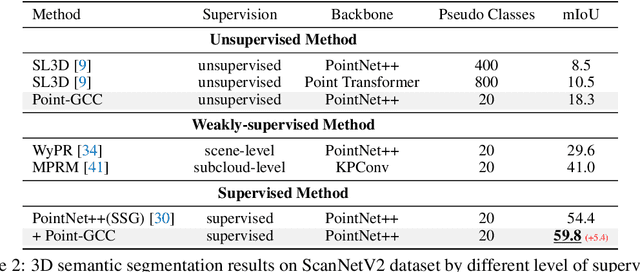
Abstract:Geometry and color information provided by the point clouds are both crucial for 3D scene understanding. Two pieces of information characterize the different aspects of point clouds, but existing methods lack an elaborate design for the discrimination and relevance. Hence we explore a 3D self-supervised paradigm that can better utilize the relations of point cloud information. Specifically, we propose a universal 3D scene pre-training framework via Geometry-Color Contrast (Point-GCC), which aligns geometry and color information using a Siamese network. To take care of actual application tasks, we design (i) hierarchical supervision with point-level contrast and reconstruct and object-level contrast based on the novel deep clustering module to close the gap between pre-training and downstream tasks; (ii) architecture-agnostic backbone to adapt for various downstream models. Benefiting from the object-level representation associated with downstream tasks, Point-GCC can directly evaluate model performance and the result demonstrates the effectiveness of our methods. Transfer learning results on a wide range of tasks also show consistent improvements across all datasets. e.g., new state-of-the-art object detection results on SUN RGB-D and S3DIS datasets. Codes will be released at https://github.com/Asterisci/Point-GCC.
Contrast with Reconstruct: Contrastive 3D Representation Learning Guided by Generative Pretraining
Feb 05, 2023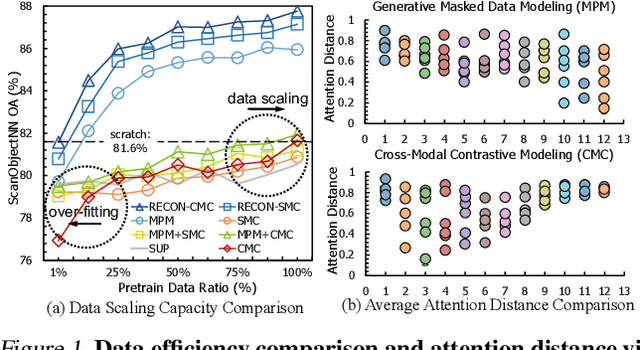
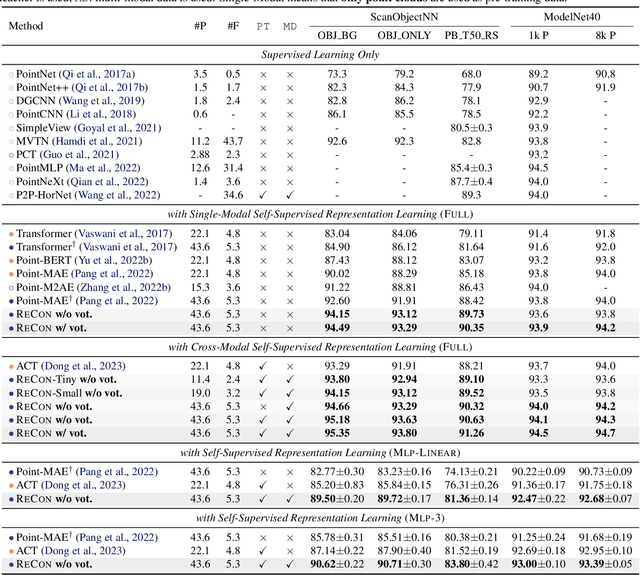
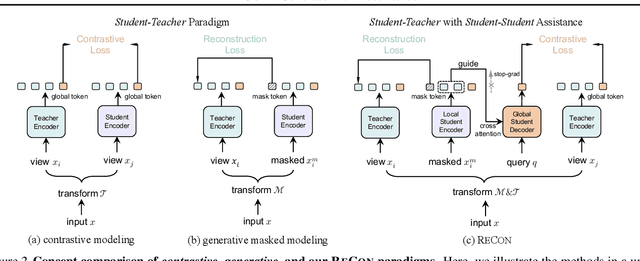
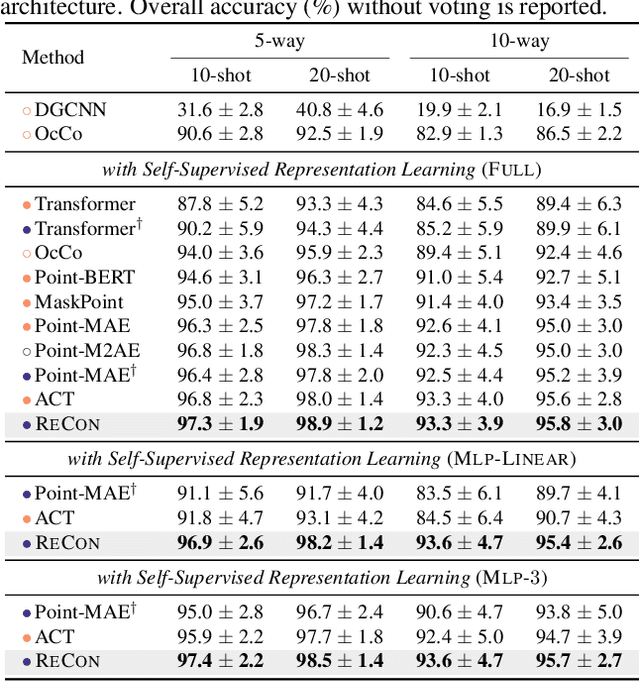
Abstract:Mainstream 3D representation learning approaches are built upon contrastive or generative modeling pretext tasks, where great improvements in performance on various downstream tasks have been achieved. However, by investigating the methods of these two paradigms, we find that (i) contrastive models are data-hungry that suffer from a representation over-fitting issue; (ii) generative models have a data filling issue that shows inferior data scaling capacity compared to contrastive models. This motivates us to learn 3D representations by sharing the merits of both paradigms, which is non-trivial due to the pattern difference between the two paradigms. In this paper, we propose contrast with reconstruct (ReCon) that unifies these two paradigms. ReCon is trained to learn from both generative modeling teachers and cross-modal contrastive teachers through ensemble distillation, where the generative student guides the contrastive student. An encoder-decoder style ReCon-block is proposed that transfers knowledge through cross attention with stop-gradient, which avoids pretraining over-fitting and pattern difference issues. ReCon achieves a new state-of-the-art in 3D representation learning, e.g., 91.26% accuracy on ScanObjectNN. Codes will be released at https://github.com/qizekun/ReCon.
Autoencoders as Cross-Modal Teachers: Can Pretrained 2D Image Transformers Help 3D Representation Learning?
Dec 16, 2022Abstract:The success of deep learning heavily relies on large-scale data with comprehensive labels, which is more expensive and time-consuming to fetch in 3D compared to 2D images or natural languages. This promotes the potential of utilizing models pretrained with data more than 3D as teachers for cross-modal knowledge transferring. In this paper, we revisit masked modeling in a unified fashion of knowledge distillation, and we show that foundational Transformers pretrained with 2D images or natural languages can help self-supervised 3D representation learning through training Autoencoders as Cross-Modal Teachers (ACT). The pretrained Transformers are transferred as cross-modal 3D teachers using discrete variational autoencoding self-supervision, during which the Transformers are frozen with prompt tuning for better knowledge inheritance. The latent features encoded by the 3D teachers are used as the target of masked point modeling, wherein the dark knowledge is distilled to the 3D Transformer students as foundational geometry understanding. Our ACT pretrained 3D learner achieves state-of-the-art generalization capacity across various downstream benchmarks, e.g., 88.21% overall accuracy on ScanObjectNN. Codes will be released at https://github.com/RunpeiDong/ACT.
 Add to Chrome
Add to Chrome Add to Firefox
Add to Firefox Add to Edge
Add to Edge